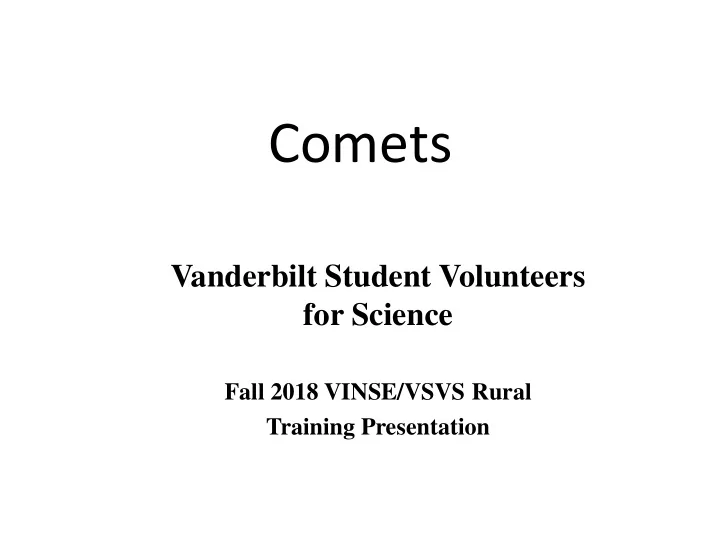

Comets Vanderbilt Student Volunteers for Science Fall 2018 VINSE/VSVS Rural Training Presentation
Introduction Comets are left over debris from the period of the early formation of our • solar system. Comets may have brought water and carbon-based molecules to earth. • These are the molecules that make up living things. Most comets are too small to be seen without a telescope. • Comets orbit the sun. •
Where Comets are found Comets spend most of their time out past Pluto. • Gravity can pull a comet closer to the sun. • It is rare to see one come close to Earth, but it does happen. • – In 1986 the first picture of the interior of a comet was taken by the Giotto spacecraft. It was found that a comet’s surface is not smooth, but very rough, full of holes, and lumpy.
What a comet is made of • A comet is a dirty ball of ice! • The comet has a small nucleus in the center. • The nucleus is the solid center (50% is ice and 50% is dust and rock). • The nucleus is surrounded by a coma (this is formed when the comet gets close to the inner solar system). • The comet may have 1 or 2 tails – The dust tail is produced as the ices evaporate and drag dust particles off the surface of the comet. – The ion tail is produced by the solar wind which converts some of the comet’s gases into electrically charged particles called ions.
Making a Comet • Put on goggles. • Add 50mL of water to a sandwich bag • Add 2 tsp of non-organic material (sand/dirt) to the water. • Stir well until the water and the sand is blended. • Add 1 spoon of ground charcoal. Stir well. • Add a squirt of ammonia. • Continue to stir.
Making a comet contd Put on the working gloves. • Add the powdered dry ice to the • bag and place the bag on the plate. Agitate gently. Wait until the mixture is almost • frozen (it will stop bubbling).
Making a comet contd Lift the bag up and shape it into a • snow ball by holding the bag tightly. Add more water if needed. Unwrap the comet and put on • the plate.
Final comet
Seeing the Tails • Distribute 1 oz cup with a piece of dry ice to students. • Add some water to the cup of dry ice so that a trail is developed. • Tell one member of the group to hold the cup and move it in the air. • Students should notice a trail behind the piece. This would represent the dust/gas cloud that is always behind the comet.
Seeing tails • Tell another student in the group to represent the sun and to blow across the path of the dry ice pieces. Students should see another cloud in a different direction. This represents the ion cloud that can be seen when comets get near the sun.
Asteroids and Meteoroids • Asteroids do not have much ice and do not have tails • Meteoroids are similar to asteroids but much smaller. They are probably pieces of asteroids. • Trace the orbit of the asteroid belt. • Show the students the meteorite samples and tell them that it was found in Odessa, Texas.
Clean Up • Collect all dirty comets and place in trash bag. • Tie the bag and then poke a few holes in the top. This should prevent the bag from exploding! • Please take it out of the VSVS kit when you get back to the lab and hand it to a VSVS lab assistant. • Place all cups in another trash bag and return to the lab. They will be reused.
Recommend
More recommend